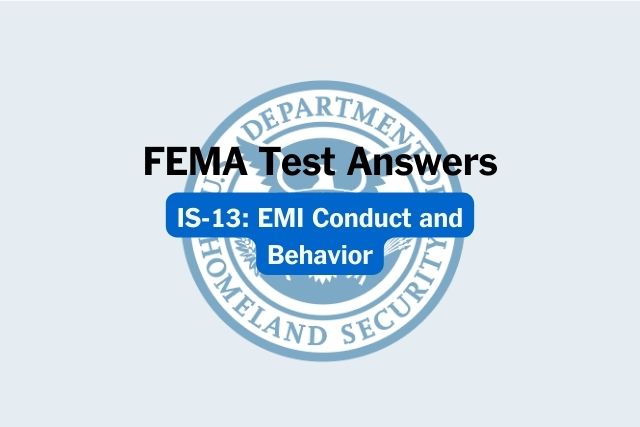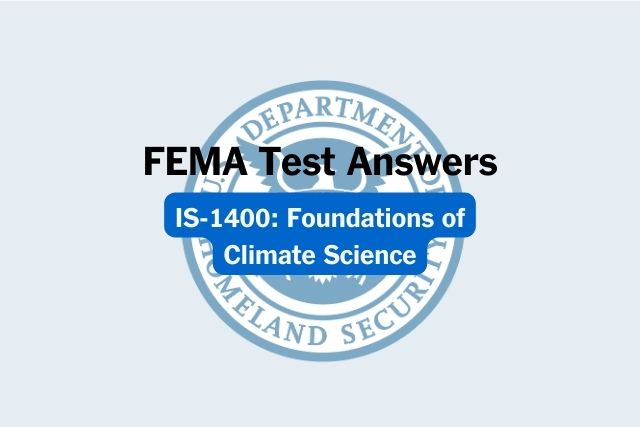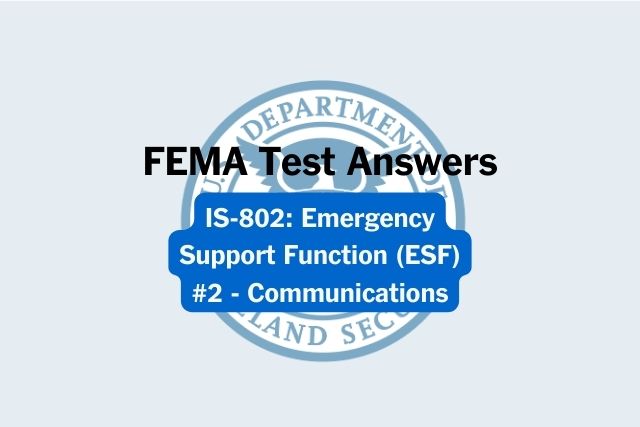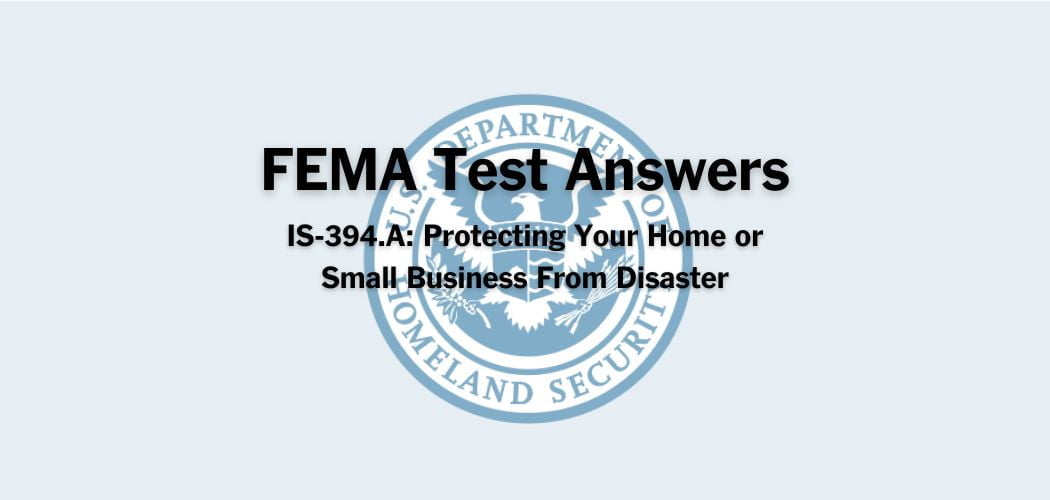Overview: The FEMA IS-2500 course was published on 3/27/2018 to introduce participants to the concepts and principles of the National Prevention Framework. The goal of this course is to familiarize participants with the National Prevention Framework which provides guidance for all levels of government, private and nonprofit sector partners, and individuals to prevent, avoid, or stop a threatened or actual act of terrorism.
Primary audience: FEMA IS-2500 is for government executives, private-sector and nongovernmental organization (NGO) leaders, and emergency management practitioners. This includes senior elected and appointed leaders, such as Federal department or agency heads, State Governors, mayors, tribal leaders, and city or county officials – those who have a responsibility to provide for effective prevention.
FEMA IS-2500 test answers
Each time this test is loaded, you will receive a unique set of questions and answers. The test questions are scrambled to protect the integrity of the exam.
Question 1. Which of the three cross-cutting core capabilities is described as the establishment and maintenance of a unified and coordinated operational structure and process that appropriately integrates all critical stakeholders and supports the execution of core capabilities?
A. Planning
B. Operational Coordination ✅
C. Public Information and Warning
Question 2. Which Federal coordinating structure is a collaborative effort led jointly by DHS and the FBI that identifies and reports suspicious activity in jurisdictions around the country?
A. National Counterterrorism Center
B. National Joint Terrorism Task Force
C. National Suspicious Activity Reporting Initiative ✅
D. National Operations and Coordination Center
Question 3. The National Prevention Framework applies to government leaders and law enforcement, and not to individuals.
A. TRUE
B. FALSE✅
Question 4. Which guiding principle for Prevention states that we must build and maintain the appropriate core capabilities prior to the threat and proactively deliver these capabilities in a coordinated fashion?
A. Engaged partnerships
B. Readiness to act ✅
C. Scalability, flexibility, and adaptability
Question 5. Which Federal department or agency serves as the head of the Intelligence Community, which consists of 17 elements across the Federal Government?
A. Department of Defense
B. Department of Justice
C. Office of the Director of National Intelligence ✅
D. Department of State
E. Department of Homeland Security
Question 6. Tribal governments may not provide law enforcement services, and are therefore not able to provide support for, or coordination with, local, state, territorial, and Federal governments and programs.
A. TRUE
B. FALSE✅
Question 7. Which guiding principle for Prevention states that the responsibility for prevention is shared among local, state, tribal, territorial, Federal, nonprofit, and private-sector entities?
A. Engaged partnerships✅
B. Readiness to act
C. Scalability, flexibility, and adaptability
Question 8. Which Federal coordinating structure facilitates time-sensitive incident management coordination, situational awareness, and the sharing of critical intelligence and information? One example is the FBI Strategic Information and Operations Center (SIOC).
A. National Counterterrorism Center
B. National Joint Terrorism Task Force
C. National Suspicious Activity Reporting Initiative
D. National Operations and Coordination Center✅
Question 9. Which Federal department or agency conducts the diplomacy and foreign policy of the United States to prevent terrorism and address foreign threats against the U.S. homeland?
A. Department of Defense
B. Department of Justice
C. Office of the Director of National Intelligence
D. Department of State ✅
E. Department of Homeland Security
Question 10. The National Prevention Framework provides guidance on how to:
A. Prevent damage from a natural disaster, such as a tornado or a flood.
B. Reduce the loss of life and property by lessening the impact of disasters.
C. Save lives, protect property and the environment, and meet basic human needs after an incident has occurred. ✅
D. Prevent, avoid, or stop a threatened or actual act of terrorism.
Question 11. Which coordinating structure is the focal point within a state or local government for the receipt, analysis, gathering, and sharing of threat-related information between the Federal government and whole community partners?
A. Joint Operations Center
B. Urban-Area Fusion Center ✅
C. Local Intelligence and Analytic Entity
D. Joint Terrorism Task Force
Question 12. Which of the following is NOT a responsibility of a local government?
A. Local governments provide leadership for services such as law enforcement and emergency management
B. Local law enforcement agencies conduct criminal investigations and can identify imminent acts of terrorism ✅
C. Local law enforcement coordinates activities with the National Guard during an incident
D. Local governments coordinate prevention resources and capabilities with neighboring jurisdictions
Question 13. Which of the following does NOT describe core capabilities?
A. They are distinct critical elements necessary to meet the National Preparedness Goal.
B. They provide a common language for preparedness across the whole community.
C. They are exclusive to the federal government and cannot be applied at the local level. ✅
D. They are essential for the execution of each mission area: Prevention, Protection, Mitigation, Response, and Recovery.
Question 14. The Prevention FIOP contains unique planning considerations for several terrorist threats, such as aircraft as a weapon.
A. TRUE ✅
B. FALSE
Question 15. Which guiding principle for Prevention states that officials from all levels of government may elect to execute only some of the prevention capabilities?
A. Engaged partnerships
B. Readiness to act
C. Scalability, flexibility, and adaptability✅
Question 16. Which of the three cross-cutting core capabilities is described as the delivery of coordinated, prompt, reliable, and actionable information to the whole community through the use of clear, consistent, accessible, and culturally and linguistically appropriate methods to effectively relay information regarding any threat or hazard, as well as the actions being taken and the assistance being made available, as appropriate?
A. Planning
B. Operational Coordination
C. Public Information and Warning✅
Question 18. Which of the three cross-cutting core capabilities is described as a systematic process engaging the whole community as appropriate in the development of executable strategic, operational, and/or tactical-level approaches to meet defined objectives?
A. Planning ✅
B. Operational Coordination
C. Public Information and Warning
Question 19. Which Federal department or agency has the lead responsibility for criminal investigations of terrorist acts or threats within the United States?
A. Department of Defense
B. Department of Justice ✅
C. Office of the Director of National Intelligence
D. Department of State
E. Department of Homeland Security
Question 20. Which Prevention core capability includes the collection and examination of evidence associated with a terrorist act and the fusion of the science-based technical examination results, intelligence information from all sources, and other investigative information?
A. Intelligence and Information Sharing ✅
B. Screening, Search, and Detection
C. Forensics and Attribution
D. Interdiction and Disruption



